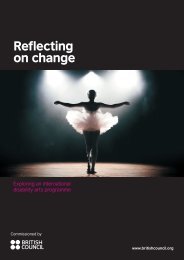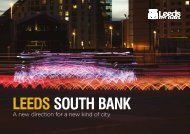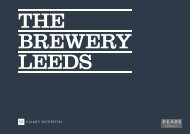Reflecting Change_Design_V3b
You also want an ePaper? Increase the reach of your titles
YUMPU automatically turns print PDFs into web optimized ePapers that Google loves.
Reflecting
on change
Exploring an international
disability arts programme
www.britishcouncil.org
‘ It’s essential to advocate for a sustainable
future for disability arts and inclusive arts’
Cover image:
The Nature of Why, Paraorchestra
Photo: Paul Blakemor
© British Council 2021. All rights reserved.
Author: Tim Wheeler
This is an independent report commissioned by the British Council. Aside from the Foreword and
Afterword, the views expressed are those of the author, based on extensive interviews and research, and
do not necessarily reflect the views of the British Council.
www.britishcouncil.org
The British Council is the UK’s international organisation for cultural relations and educational
opportunities. We work with more than 100 countries in the fields of arts and culture, English language,
education and civil society. Last year we reached more than 65 million people directly and 731 million
people overall including online, broadcasts and publications. We make a positive contribution to the
countries we work with – changing lives by creating opportunities, building connections and engendering
trust. Founded in 1934, we are a UK charity governed by Royal Charter and a UK public body. We receive
a 15 per cent core funding grant from the UK government.
Reflecting on change
3
Foreword: British Council
About one in seven people in the world
is disabled. That’s around 15 per cent of
the global population – about one billion
individuals worldwide.
Some disabilities are visible, some are invisible, but
too often disabled people face barriers to inclusion
in society. These barriers might be physical, to do
with other people’s attitudes, or because of systemic
discrimination.
As the UK’s international organisation for cultural
relations, the British Council’s work builds enduring
relationships across different cultures. We cannot do
this without a strong commitment to equality.
Equality, diversity and inclusion are constant themes
in everything we do around the world: arts, society,
education, teaching English and offering exams. Our
initiatives bring different people together, enriching their
experience and leading to more inclusive societies.
That’s why we have such a strong commitment to arts
and disability. Disability arts have been an important
part of the British Council’s global programme for
decades and a key focus since 2012.
Our recent work in arts and disability has taken place
in more than 50 countries. We partner with disabled
artists, disabled-led companies and inclusive arts
organisations from all over the world, creating a legacy
of transformation.
As we respond to the global Covid-19 pandemic, it
is important to highlight the value of international
connections in disability arts. And it’s essential to
advocate for a sustainable future for disability arts and
inclusive arts.
This report gives an insight into our disability arts
work since 2012 and the impact on individuals and
societies. It illustrates how we’ve worked with different
methods in different cultural contexts. At the same
time, we’ve endeavoured to help disabled artists and
cultural leaders claim their places at the centre of the
international disability arts conversation.
From helping to establish the first integrated theatre
company in Bangladesh to supporting the first disability
arts conference in Qatar, we are proud to be part of the
global arts and disability movement.
Why read this report?
As we all look to build a more equitable society, we hope
this report will assist policymakers, funders, researchers,
organisations and practitioners who are working with
arts and disability, those who would like to do so, and
those who identify as disabled themselves.
For instance, you might:
• Explore approaches to disability arts and international
exchange, at a time when there’s growing awareness
of the importance of addressing historical
imbalances.
• Reflect on the impact this work can have from artistic,
economic, social and personal perspectives.w
• Get a sense of the structures that support UK
disability arts, and appreciate why activity and
confidence have increased since 2012.
• Learn about the sectors in countries including
Bangladesh, South Korea and Indonesia, and discover
individual artists’ stories.
• Locate resources that we have produced or used in
our work.
• Find out what worked in our projects and where we
hope to improve.
• Consider future challenges for the cultural sector to
address.
What follows is a reflection on our journey of change
by disability arts specialist Tim Wheeler. Along the way,
we’ve been inspired by remarkable artists, partners and
campaigners. By sharing our experience, we hope to
encourage others on their own journeys.
Kate Ewart-Biggs OBE
Deputy Chief Executive
British Council
Reflecting on change
4
Section one: Approaches to disability arts
The medical model and the social model
Two models for discussing disability have dominated
the UK’s conversation for the past 40 years. UK charity
Scope defines them like this:
• ‘The medical model of disability says [a person’s]
impairments or differences disable people. The
medical model looks at what is “wrong” with the
person, not what the person needs. We believe it
creates low expectations and leads to people losing
independence, choice and control in their lives.’
• ‘The social model says that people are disabled
by barriers in society, not by their impairment or
difference. Barriers can be physical, like buildings
not having accessible toilets. Or they can be caused
by people’s attitudes to difference, like assuming
disabled people can’t do certain things.’
The British Council supports a social model approach to
disability arts and inclusive arts practice.
Disability arts and inclusive arts
• Disability arts is work that disabled people lead.
It may or may not be about disability issues, and it
may or may not involve non-disabled practitioners.
Significantly, power and control rest with the disabled
practitioner.
• Inclusive arts involves both disabled and nondisabled
people and is often led by non-disabled
practitioners.
The British Council does not impose either of these
positions as there are many ways disabled people
engage with the arts worldwide.
Neither of these definitions is explicitly designed to help
us understand disability arts and culture. There is a
need for a more in-depth discussion about the purpose
of art-making by disabled people.
This study does not look at the arts as a therapy or for
purely recreational purposes.
Artistic approaches
Disabled academics such as Tobin Seibers, Tom
Shakespeare and Petra Kuppers have begun to
articulate a more nuanced definition of disability art
and culture. They offer ways to critically reflect on the
artistic processes and products of disabled people
using the language of disability culture and aesthetics
rather than social or medical terms.
The following is a brief overview of some different
approaches to disability arts. It’s intended to be a
starting point for discussion, not a final list. The aim is to
help us think about the aesthetic and political impact of
disability arts initiatives.
• Arts therapy: Aligned with the medical model
of disability, practitioners aim to use the arts for
therapeutic effect, cure a condition or alleviate
suffering.
• Outsider Art: Work that exists outside the
influences of the dominant culture, for instance, in
psychiatric institutions.
• Aesthetics of difference: Sees diversity of
experience in artists as a strength, an expression of
the beauty of human variation and a way to share
new perspectives.
• Arts activism: Uses arts practice to confront
social barriers, sometimes as part of direct action,
and challenges socially defined issues such as
discrimination.
• Disability Pride: Events that are about being ‘out
and proud’. They often foreground outrageous
humour, extravagance, cabaret and procession to
show joy within the disability community.
• Aesthetics of access: Art that integrates access
tools (such as sign language or audio description)
into the creative process as work is made, so that it’s
a core part of the art rather than an ‘add-on’.
Reflecting on change
5
‘ Disability arts is the last
remaining avant-garde
movement.’
Yinka Shonibare, artist (UK)
In Brief
The British Council supports a social model
approach to disability arts, which says
that social barriers rather than individual
impairments disable people.
The organisation works with both disability
arts (led by disabled people) and inclusive
arts (often led by non-disabled practitioners).
The sector can consider the artistic impact
of disability arts by exploring approaches
such as aesthetics of difference, arts
activism and aesthetics of access.
There is a need for deeper critical reflection
on disability arts practices.
Marc Brew & Bora Kim, Zero: Restriction, Body and Time
Image credit: Susan Hay






